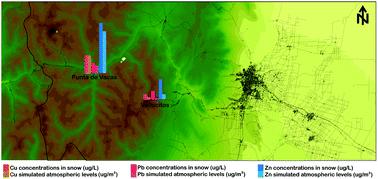当前位置:
X-MOL 学术
›
Environ. Sci.: Processes Impacts
›
论文详情
Our official English website, www.x-mol.net, welcomes your
feedback! (Note: you will need to create a separate account there.)
Identifying patterns and sources of anthropogenic trace metals in the Argentine Central Andes by using snow samples and an atmospheric dispersion model.
Environmental Science: Processes & Impacts ( IF 4.3 ) Pub Date : 2020-05-21 , DOI: 10.1039/d0em00096e Maria F Ruggeri 1 , Paula S Castesana 2 , Tomas R Bolaño-Ortiz 3 , Salvador E Puliafito 3 , Romina M Pascual Flores 3 , Jorgelina C Altamirano 4 , David G Allende 5
Environmental Science: Processes & Impacts ( IF 4.3 ) Pub Date : 2020-05-21 , DOI: 10.1039/d0em00096e Maria F Ruggeri 1 , Paula S Castesana 2 , Tomas R Bolaño-Ortiz 3 , Salvador E Puliafito 3 , Romina M Pascual Flores 3 , Jorgelina C Altamirano 4 , David G Allende 5
Affiliation

|
This study presents the first local measurements of metals in snow from the Argentine Central Andes. Cu, Pb and Zn were selected as specific tracers of anthropogenic local emission sources in the study area. Snow samples were collected during winter (2014, 2015 and 2016) at two sites with different characteristics: Punta de Vacas and Vallecitos. The samples were analyzed by ICP-MS, and the average concentrations found were 1.4 μg L−1 (Cu), 2.2 μg L−1 (Pb) and 14.2 μg L−1 (Zn) in the snow samples from Vallecitos, and 5.3 μg L−1 (Cu), 2.6 μg L−1 (Pb) and 24.0 μg L−1 (Zn) in the snow samples from Punta de Vacas. These data and the snowfall amount in each sampling site were statistically analyzed. Results suggested that the levels of metals in the snow are influenced not only by the atmospheric concentrations, but also by the amount of precipitated snow. Additionally, an atmospheric dispersion model, CALPUFF, was applied in the study area to determine the origin of the studied metals and to understand the spatial distribution pattern of the concentrations found. Results showed that the metal atmospheric loads in the study area originated from local sources, especially vehicular traffic and mining. This work represents an important contribution to the knowledge and preservation of the local Andean cryosphere, and it could be used as an input to develop protection policies in the area through the combination of different and complementary tools for the evaluation of air quality.
中文翻译:

通过使用雪样和大气弥散模型,识别阿根廷中部安第斯山脉中人为痕量金属的模式和来源。
这项研究提出了阿根廷中部安第斯山脉雪中金属的第一个局部测量。选择Cu,Pb和Zn作为研究区域人为局部排放源的特定示踪剂。冬季(2014年,2015年和2016年)在两个具有不同特征的地点采集了雪样:蓬塔瓦卡斯(Punta de Vacas)和瓦莱奇托斯(Vallecitos)。通过ICP-MS分析样品,发现来自Vallecitos的雪样中的平均浓度为1.4μgL -1(Cu),2.2μgL -1(Pb)和14.2μgL -1(Zn),以及5.3微克L -1(Cu),2.6微克L -1(Pb)和24.0微克L -1蓬塔瓦卡斯的雪样本中的锌(Zn)。对这些数据和每个采样点的降雪量进行统计分析。结果表明,雪中的金属含量不仅受大气浓度的影响,还受沉淀雪量的影响。此外,在研究区域中采用了大气扩散模型CALPUFF,以确定所研究金属的来源并了解所发现浓度的空间分布模式。结果表明,研究区域中的金属大气负荷源自本地资源,尤其是车辆交通和采矿。这项工作为当地安第斯冰冻圈的知识和保护做出了重要贡献,
更新日期:2020-07-22
中文翻译:

通过使用雪样和大气弥散模型,识别阿根廷中部安第斯山脉中人为痕量金属的模式和来源。
这项研究提出了阿根廷中部安第斯山脉雪中金属的第一个局部测量。选择Cu,Pb和Zn作为研究区域人为局部排放源的特定示踪剂。冬季(2014年,2015年和2016年)在两个具有不同特征的地点采集了雪样:蓬塔瓦卡斯(Punta de Vacas)和瓦莱奇托斯(Vallecitos)。通过ICP-MS分析样品,发现来自Vallecitos的雪样中的平均浓度为1.4μgL -1(Cu),2.2μgL -1(Pb)和14.2μgL -1(Zn),以及5.3微克L -1(Cu),2.6微克L -1(Pb)和24.0微克L -1蓬塔瓦卡斯的雪样本中的锌(Zn)。对这些数据和每个采样点的降雪量进行统计分析。结果表明,雪中的金属含量不仅受大气浓度的影响,还受沉淀雪量的影响。此外,在研究区域中采用了大气扩散模型CALPUFF,以确定所研究金属的来源并了解所发现浓度的空间分布模式。结果表明,研究区域中的金属大气负荷源自本地资源,尤其是车辆交通和采矿。这项工作为当地安第斯冰冻圈的知识和保护做出了重要贡献,











































 京公网安备 11010802027423号
京公网安备 11010802027423号